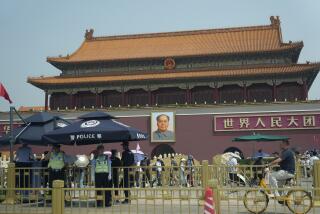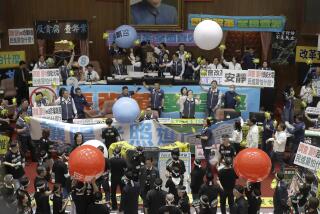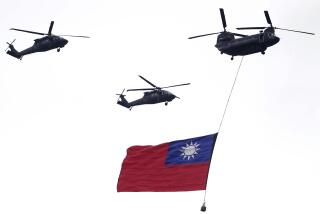China, Taiwan Move 95 Miles Closer to Political Cooperation
WASHINGTON â Last Friday, 10 Taiwanese business leaders sailed from the Taiwan-controlled islet of Kinmen to Xiamen on the Chinese mainland. The unprecedented trip, along with other recent developments in Asia, raise an intriguing question: Can economic cooperation break the China-Taiwan impasse and set the stage for political reconciliation between the two countries?
One of the great puzzles--and surprises--connected to the Taiwan question is that globalization, so far, has not brought the two countries closer together politically. Economically, China and Taiwan are rapidly becoming reintegrated, forming a âgreater Chinaâ economy. Thousands of Taiwanese enterprises have invested more than $40 billion in the mainland; annual two-way trade is about $30 billion, up nearly 30% from last year. Some 3 million Chinese serve as a huge production platform for Taiwan and Hong Kong exports.
Political scientists say that such economic interdependence should promote a peaceful situation with a shared stake in stability. But the impressive economic developments--even cross-strait deals involving Chinese President Jiang Zeminâs son in a multibillion-dollar semiconductor factory in Shanghai--have not substantially altered the political perspective of either Beijing or Taipei. Beijing still demands that Taiwan agree to its notion of a âone Chinaâ policy before any political talks can begin; democratic Taiwan has no interest in uniting with a communist-ruled mainland, but wants a dialogue in which some form of union can be discussed as part of a larger agenda of more practical concerns.
But things may be poised for change. In a modest gesture, Taiwan recently opened direct-trade, travel and communications ties with two Taiwanese islets that are less than five miles from the mainland. (Taiwan is about 100 miles away). Last week, Beijing allowed the first legal visits from Xiamen to relatives at Kinmen, one of the tiny islets. Furthermore, Taiwan President Chen Shui-bian offered some conciliatory words in a New Yearâs message, saying that âone Chinaâ is no problem under his countryâs constitution. Beijing also showed signs of flexibility on integration: Its deputy prime minister and point man on Taiwan, Qian Qichen, suggested that China has adopted a more âpragmatic and inclusiveâ approach, including a willingness to consider a loose confederation.
Taiwanâs establishment of âmini-linksâ with the two islets reflect a rare recognition of reality often missing on both sides of the Taiwan question. So do the remarks by Chen and Qian. Taiwanâs business community is eager to move forward on larger links--air, sea and postal. This would make cross-strait business, much of which now takes a circuitous route through Hong Kong, easier, cheaper and more efficient. The pressure is magnified by the near-certainty that both Beijing and Taipei will enter the World Trade Organization. Once that happens, both will have to open their markets to each other and reach new trade arrangements.
Since Taiwan will enter the WTO as a customs union, rather than as a separate state, it should be easier to deal with sovereignty-related issues such as: What flag do ships and planes fly? WTO membership will also provide Taiwanese investors with a greater sense of confidence and safety, thus possibly accelerating cross-strait trade and investment.
The unanswered question is whether or not these developments will amount to anything more than political theater. There have been no authoritative cross-strait talks since July 1999, when then-President Lee Teng-hui declared a âtwo-stateâ theory that infuriated China. Beijing has badly misread Chen since his inauguration, failing to respond to his âfuture one Chinaâ statement, hints that he would accept a 1992 consensus as the basis for resuming cross-strait dialogue and his conciliatory âone Chinaâ is no problem.
Instead, the mainland is pursuing âunited frontâ tactics. It has wined and dined members of Taiwanâs opposition parties and businessmen to pressure Chen to be more forthcoming. But the likelihood that internal political turmoil will force Chen out before his term expires is diminishing. Since 1995, every attempt by Beijing to influence Taiwanese politics has backfired. For example, Beijingâs âmissile diplomacyâ against former President Lee increased his margin of victory in 1996; its threats against Chen facilitated his narrow victory in 2000.
Another factor influencing the timing of Beijingâs actions is the new Bush administration. One of the first tests of its China policy will come in April, when President George W. Bush must decide on whether to sell particular weapons systems to Taiwan. By reducing cross-strait tensions, China could alter Taiwanâs weapons requests and/or which arms Bush decides to sell it. Beijing is particularly worried about Taiwanâs interest in acquiring Aegis cruisers and ballistic-missile defense systems to counter its buildup of missiles in Fujian province, just across from Taiwan.
A resolution of the Taiwan question is probably a generation away. But the old framework needs to be adjusted. Beijingâs âone country, two systemsâ cliche is a non-starter in Taiwan, especially since Hong Kong looks more like one country than two systems. Accordingly, the positive gestures made by Chen should be enough for Beijing to at least test his intentions. Why not hold high-level talks to discuss a looser definition of âone Chinaâ?
Beijingâs exploration of other ways to achieve its âone Chinaâ goal should start from the reality that for more than 50 years, China has been divided and there is an autonomous political entity governing Taiwan. For its part, Taiwan should recognize that its legitimate desire for international political space, including participation in U.N. organizations, may require it to make some accommodations with Beijing. The dynamic of cross-strait economic interaction may be the catalyst.
More to Read
Sign up for Essential California
The most important California stories and recommendations in your inbox every morning.
You may occasionally receive promotional content from the Los Angeles Times.










